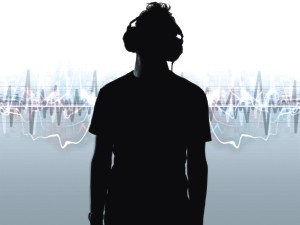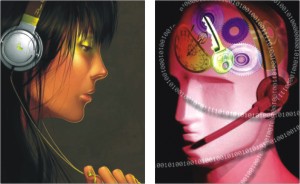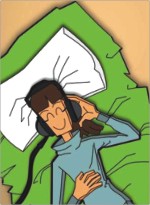
By Sabrina F Ahmad
 I Hurried towards my car, late for class, and on the way, spotted the newspaper boy and the receptionist at our apartment comparing their latest toys; the former showing off a small radio, and the latter his cell-phone radio.
I Hurried towards my car, late for class, and on the way, spotted the newspaper boy and the receptionist at our apartment comparing their latest toys; the former showing off a small radio, and the latter his cell-phone radio.
“Boys will be boys and play with their toys” I muttered, shaking my head.
The classroom was jam-packed when I entered, and I slid into the nearest available seat at the back.
“What did I miss?” I asked the person next to me. No response. I tapped her on her shoulder. She started up, took a few guilty glances around her, removed her earphones (carefully masked by her long hair and dupatta), and asked me what I wanted. The tiny, mp4 player twinkled conspiratorially at me from her lap.
“Sir's lectures are so boring” she sheepishly offered, by way of explanation.
When I hit the road, it seemed like everyone was wired to some portable music device or the other. From the uber-cool trend-setting crowds with their sleek mp3 players, to the 'hiff-hoff' (that's how they pronounce it!) public and their fake ipods or loud radio phones…everyone had one of those gadgets. Then there was the solitary rickshawallah with his feet propped up on his rickshaw handles as he reclined in solitude on his 'tea-break', the wires from his ears disappearing into a mysterious bulge in his breast pocket. Had I just woken up in some Twilight Zone like place where I was the only one not attached to some apparently brain-numbing musical gadget?
 “How did it get like this?”
“How did it get like this?”
“You really want to know?”
I wheeled around at the unexpected reply to my unspoken question, but there was no one there.
“Check your pocket, sweets”
I slipped my hand in, and pulled out a flat, box-like instrument with a tiny LCD monitor, a circular dial, and a pair of earphones attached to it. The display read '2006'.
“What the…how did that get in there?”
“Will you just put it on?” The voice in my head sounded exasperated.
Feeling ever so gauche, I slipped on the earphones. My fingers, of their own accord, turned the dial, so that the numbers on the display began to change. There was a sudden ear-splitting shriek, and suddenly, my world went white.
1180 AD The Mobile musician
“King Louis VII has died earlier this year, to be succeeded by the ambitious Philippe II. In the neighbouring country of England, a young and restless Richard, son of the Young King Henry II, is planning to ally with the French monarch against his own father.”
The monologue ended, and I opened my eyes to find myself standing on a cobbled street near a pair of massive city gates. A young man bearing a lute approached the gate, and was met by the guard there.
“Ho there, good traveller. Who might ye be, and where might ye be headed?”
“I am a troubadour, sire. I travel the land, exchanging song for board and bed”
“Alright then…walk, man. Wind to thy wings”
“…and that's how the idea of portable music began” added the voice in my head.
“Funny…”
“Just turn the dial, will you? There's more where that came from.”
Bracing myself for another shriek, I complied.
1877 Mary had a little lamb
 This time, when my ears stopped ringing, I found myself in a dusty old workshop, dimly lit by oil lamps. There were two men examining something on a worktable, and as my eyes grew accustomed to the light, I realised with a start that the balding one was Thomas Edison. We were finally getting somewhere.
This time, when my ears stopped ringing, I found myself in a dusty old workshop, dimly lit by oil lamps. There were two men examining something on a worktable, and as my eyes grew accustomed to the light, I realised with a start that the balding one was Thomas Edison. We were finally getting somewhere.
The great inventor had made some serious breakthroughs with his telegraph, and his success led him to speculate that a telephone message could also be recorded in a similar fashion. He experimented with a diaphragm, which had an embossing point and was held against rapidly moving paraffin paper. The speaking vibrations made indentations in the paper. Edison later changed the paper to a metal cylinder with tin foil wrapped around it. The machine had two diaphragm-and-needle units, one for recording, and one for playback. When one would speak into a mouthpiece, the sound vibrations would be indented onto the cylinder by the recording needle in a vertical (or hill and dale) groove pattern.
He gave his drawings his mechanic, John Kreusi, whom I guessed was the other guy in the room. Kreusi completed the machine in 30 hours.
“This is what you wanted, sir?”
“Looks like it. Let's try it out.”
Edison bent close to the mouthpiece, and I waited with bated breath as history unfolded in front of me.
“Mary had a little lamb…”
“Mary had a little lamb…”
The two men whooped with joy, and hugged each other. They had invented the phonograph. As I turned the dial on my magic mp3 player, I couldn't help but wonder why he had to choose a nursery rhyme for such a moment…
1970's The boom box craze
This time, my fingers slipped on the dial as I tried to turn it, and I zipped past the introduction of the LP by Columbia Records in 1948, and the invention of the first audio cassette in 1963 by Philips.
I floated through most of the 70's and spotted a whole bunch of young people running around with large transistor sets, which they referred to as boom boxes.
In the mid-70s, when the idea of a "personal" stereo experience was a bit of a novelty. Panasonic, Sony, Marantz and GE were quick to debut this hybrid stereo--not quite a home stereo console, but more than a portable combination radio-cassette. The models were small, heavy and black--sound quality and AM/FM tuning was quite good. The pinnacle in functionality was an array of input and output jacks, so the stereo could be integrated with other audio equipment, like microphones and turntables.
Impatient to move on, I turned the dial
1979 Walkman…no, for real!
 Suddenly, I found myself back in my old house; an invisible spectator sitting on a ratty rattan armchair as my parents, a younger version of them at any rate, sauntered in. From Mom's short, Abba-inspired hair, and Dad's Sholay-inspired get up, I guessed this was the early 80's. She was squealing over his latest present to her, a bulky, rectangular object the size of a lunchbox, attached to a pair of mammoth headphones that could have passed for Siberian ear-muffs.
Suddenly, I found myself back in my old house; an invisible spectator sitting on a ratty rattan armchair as my parents, a younger version of them at any rate, sauntered in. From Mom's short, Abba-inspired hair, and Dad's Sholay-inspired get up, I guessed this was the early 80's. She was squealing over his latest present to her, a bulky, rectangular object the size of a lunchbox, attached to a pair of mammoth headphones that could have passed for Siberian ear-muffs.
“It's called a Walkman” he was explaining to her.
Organisational changes were taking place at Sony in 1979 and the tape recorder division was pressed to market something soon, or risk consolidation. They came up with a small cassette player capable of stereo playback. The invention was born from a tweaked Pressman (Sony's monaural portable cassette recorder) and a pair of headphones.
The final design of the TPS-L2, the personal stereo cassette player was completed on March 24, 1979. Sony then formulated a unique marketing campaign to sell the contraption, and the new product, being a descendant of the Pressman, came to be known as the Walkman.
The 90's Age of the spinning saucers
As I slowly turned the dial, I knew I didn't really need the weird gadget to tell me what came next. I'd witnessed the next developments myself. The Walkman gradually shrank, and became more compact, sleeker.
The Compact Disc (CD) reached the market in late 1982 in Asia and early the following year in other markets; for example, it was released in the United States in March, with the first CDs available being 16 Japanese-made titles from CBS/Sony. Audio CD's in English, Hindi, and other languages more familiar to us came much later.
It was towards the mid 90's that we started seeing the Discman, which was the nickname given to Sony's first portable CD player, the D-50, which was the first on the market in 1984, and adopted for Sony's entire portable CD player line. Not quite as handy as the Walkman, you wouldn't find too many teens carrying these around everywhere they went.
Knowing where the story ended, I turned the dial back to 2006, because now I'd be able to fill in the gaps myself.
Enter the iPod
Researchers had always been tinkering with the process of increasing the portability of music, and the first non-mechanical digital audio player in the world, the MPMan F10 was created by SaeHan Information Systems in 1997. It was a 32MB portable that appeared in the US markets in the summer of 1998. It was a very basic unit and wasn't user expandable.
The second DAP (but widely considered the first mass-market player) was the Rio PMP300 from Diamond Multimedia, introduced in September 1998. Other developments included the Sensory Science's Rave MP2300, the I-Jam IJ-100, and the Creative Labs Nomad. These portables were small and light, but only held enough memory to hold around 7 to 20 songs at normal 128 kbit/s compression rates.
The arrival of Apple Computer's iPod in 2001, combined with the iTunes software that all but created the legal-music-download business, caused an unprecedented market demand for portable music. Before you could say 'mp3', a dozen other companies brought out their own versions of the DAP. Music had never been so popular. The rest, as my mysterious friend (who disappeared as soon as I arrived back to the present) would say, is history.
